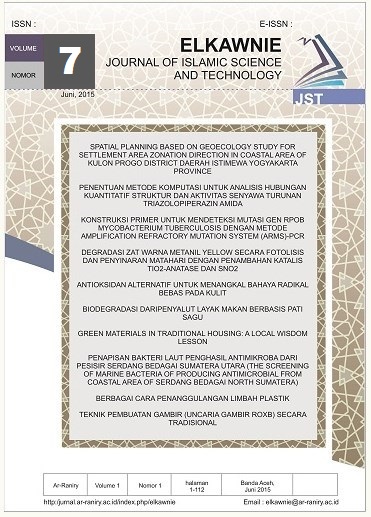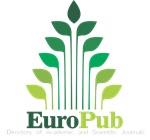Geothermal Distribution Analysis of Geureudong Volcano Based On Satellite Data and Fault Fracture Density (FFD)
DOI:
https://doi.org/10.22373/ekw.v7i2.9728Keywords:
NDVI, NDWI, LST, FFDAbstract
Abstract: Geureudong Volcano area, Bener Meriah, has the potential to be developed as a renewable energy source. Analysis of the distribution of geothermal manifestations can be done with remote sensing techniques and direct measurement. Furthermore, information on geomorphological conditions, surface temperature, and geothermal potential distribution can be known based on the density value on the FFD (Fault Fracture Density) map and satellite image processing results. Data processing uses ArcGIS and ENVI software concerning geothermal manifestations. The analysis was performed by converting DEMNAS data to a hillshade for drawing straightness structures related to the fault. Image data processing to obtain vegetation density (NDVI), hydrological state (NDWI), and surface temperature distribution (LST). NDWI values are inversely proportional to NDVI. The LST value depends on the density of the vegetation; the higher the vegetation density, the lower the surface temperature. The FFD map is divided into three levels i.e. low (0-0.17 km/km2), moderate (0.17-0.47 km/km2) and high (0.47-1.2 km/km2). The distribution of geothermal potential is at medium and high-density levels, including the Silih Nara, Wih Pesam, and Pintu Rime Gayo areas. The straightness direction is in the north-south and southeast-northwest positions. Based on the NDVI, NDWI, and LST map analysis results, geothermal energy distribution has a rare to moderate vegetation density with surface temperatures ranging from 25.8oC-39.6oC. The result clearly shows that the Geureudong geothermal distribution is initial information before in situ exploration is carried out.
Abstrak: Gunung berapi Geureudong, Bener Meriah, sangat prospektif untuk dikembangkan terutama sebagai sumber energi terbarukan. Analisis sebaran manifestasi panas bumi dapat dilakukan dengan teknik penginderaan jauh dan pengukuran langsung. Informasi geomorfologi, temperatur permukaan dan sebaran potensi panas bumi dapat diketahui berdasarkan nilai densitas pada peta FFD (Fault and Fracture Density) dan hasil pengolahan citra satelit Landsat 8. Pemrosesan data menggunakan perangkat lunak ArcGIS dan ENVI yang terkait dengan manifestasi panas bumi. Analisis dilakukan dengan mengubah data DEMNAS menjadi hillshade untuk menggambar struktur kelurusan yang berhubungan dengan sesar. Pengolahan data citra untuk mendapatkan kerapatan vegetasi (NDVI), keadaan hidrologi (NDWI) dan distribusi suhu permukaan (LST). Nilai NDWI berbanding terbalik dengan NDVI. Nilai LST tergantung pada kerapatan vegetasi, semakin tinggi kerapatan vegetasi maka semakin rendah suhu permukaan. Peta FFD dibagi menjadi tiga tingkatan; rendah (0-0,17 km/km2), sedang (0,17-0,47 km/km2) dan tinggi (0,47-1,2 km/km2). Sebaran potensi panas bumi berada pada tingkat kepadatan sedang dan tinggi, meliputi kawasan Silih Nara, Wih Pesam dan Pintu Rime Gayo. Arah kelurusan berada pada posisi utara-selatan dan tenggara-barat laut. Berdasarkan hasil analisis peta NDVI, NDWI dan LST didapatkan bahwa sebaran energi panas bumi memiliki kerapatan vegetasi jarang hingga sedang dengan temperatur permukaan berkisar antara 25.8oC-39.6oC.Hasil yang diperolehkan menunjukkan bahwa sebaran panas bumi Geureudong dengan sangat jelas tergambar sebagai informasi awal sebelum dilakukan eksplorasi lapangan (in situ).
References
Azhari, P. A., Maryanto, & S. Rachmansyah, A. (2016). Identification of Geological Structure and Its Impact to Land Surface Temperature Based on Landsat 8 Data on Blawan Geothermal Field. Jurnal Penginderaan Jauh dan Pengolahan Data Citra Digital, 13(1), 1-12.
Cesarian, D. P., Abir, I. A., & Isa, M. (2018). Comparison of In-Situ Temperature and Satellite Retrieved Temperature in Determining Geothermal Potential in Jaboi Field, Sabang. In Journal of Physics: Conference Series (Vol. 1116, No. 3, p. 032008). IOP Publishing.
Domra, K., Janvier, Noël, D., Danwe, R., Philippe, N. N., & Abdouramani D. (2015). A Review of Geophysical Methods for Geothermal Exploration. Renewable and Sustainable Energy Reviews 44. 87–95. doi: 10.1016/j.rser.2014.12.026.
Gunawan, H. Caudron, C. Pallister, J. Primulyana, S. Christenson, B. Macausland, W. Hinsberg, V. Lewcki J. Rouwet, D. Kelly, P. Kern, C Werner, C. Johnson, J.B. Utami, (2016). New Insights into Kawah Ijen Volcanic System from The Wet Volcano Workshop Experiment, Geological Society London Special Publications, 437, doi /10.1144/SP437.7.
Hilmi, M. A. B. M. H. (2017). Integration of remote sensing and geophysical data indetecting geothermal potentials in Ulu Slim, Perak. (Master Thesis), USM.
Hewson, R. Mshiu, E. Hecker, C. van der Werff, H. van Ruitenbeek, F. Alkema, D. van der Meer, F. (2020). The application of day and night time ASTER satellite imagery for geothermal and mineral mapping in East Africa. Int J Appl Earth Obs Geoinformation. 85, https://doi.org/10.1016/j.jag.2019.101991
Isa, M. Dwiky P. Ismail A, Elin Y. Syukri S, Muksin, U. (2020) Remote Sensing Satellite Imagery and In-Situ Data for Identifying Geothermal Potential Sites: Jaboi, Indonesia. Int. Journal of Renewable Energy Development 9 (2) 2020: 237-245
Isaya, N. M., & Avdan, U. (2016). Application of open source coding technologies in the production of land surface temperature (LST) maps from Landsat: a PyQGIS plugin. Remote sensing, 8(5), 413.
Mahmud, M., Muhammad, & Abdullah H. A. (2021). Automatic Mapping of Lineaments Using Shaded Relief Images Derived from Digital Elevation Model (DEM) in Erbil-Kurdistan, northeast Iraq. Advances in Natural and Applied Sciences, 6(2): 138-146, 2012 ISSN 1995-0772.
Nugroho, S. A., Wijaya, A. P., & Sukmono, A. (2016). Analisis Pengaruh Perubahan Vegetasi Terhadap Suhu Permukaan di Wilayah Kabupaten Semarang Menggunakan Metode Penginderaan Jauh. Jurnal Geodesi Undip. Semarang.
Naufal, F., Abdi, S., & Nurhadi, B. (2017). Analisis Estimasi Energi Panas Bumi Menggunakan Citra Landsat 8 (Studi Kasus: Kawasan Gunung Telomoyo) Jurnal Geodesi Undip, 6(4). (ISSN: 2337-845X) 371-380
Endah, J., Sukir, M., & Adi, S. (2017). Pemetaan Suhu Permukaan Tanah Daerah Kawah Wurung, Kabupaten Bondowoso, Jawa Timur Dalam Penentuan manifestasi Panas Bumi. NATURAL B, 4(1).
Nasrullah, Z., Yanis, M., Marwan, & Isa, M. F.V. D. M. (2020). Assessing of Land Surface Temperature at the Seulawah Agam Volcano Area using the Landsat Series Imagery. 0th International Conference on Physics and Its Applications (ICOPIA 2020) Journal of Physics: Conference Series 1825 (2021) 012021 IOP Publishing doi:10.1088/1742-6596/1825/1/012021
Sukendar, P. M., Sasmito, B., & Wijaya, A. P. (2016). Analisis Sebaran Kawasan Potensial Panas Bumi Gunung Salak Dengan Suhu Permukaan, Indeks Vegetasi, dan Geomorfologi. Jurnal Geodesi Undip Semarang 5(2), ISSN: 2337-845X.
Sisay, A. (2016). Remote Sensing Based Water Surface Extraction and Change Detection In The Central Rift Valley Region of Ethiopia. School of Natural Resources and Environmental Studies, Wondo Genet College of Forestry and Natural Resources. Ethiopia.
Ugur, A., & Gordana J. (2016), Algorithm for Automated Mapping of Land Surface Temperature Using LANDSAT 8 Satellite Data. Hindawi Publishing Corporation Journal of Sensors, Article ID 1480307, 8 http://dx.doi.org/10.1155/2016/1480307.
Downloads
Published
Issue
Section
License
Proposed Policy for Journals That Offer Open Access Authors who publish with the Elkawnie journal agree to the following terms:
a. Authors retain copyright and grant the journal right of first publication with the work simultaneously licensed under a Creative Commons Attribution License that allows others to share the work with an acknowledgement of the work's authorship and initial publication in this journal.
b. Authors are able to enter into separate, additional contractual arrangements for the non-exclusive distribution of the journal's published version of the work (e.g., post it to an institutional repository or publish it in a book), with an acknowledgement of its initial publication in this journal.
c. Authors are permitted and encouraged to post their work online (e.g., in institutional repositories or on their website) prior to and during the submission process, as it can lead to productive exchanges, as well as earlier and greater citation of published work (see The Effect of Open Access).

























